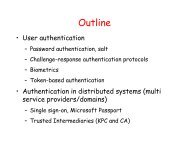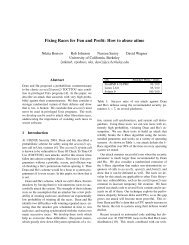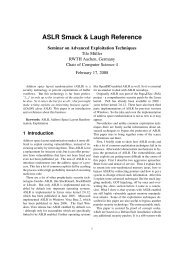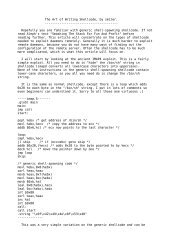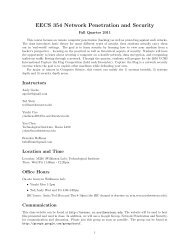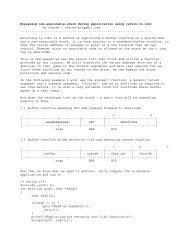Advanced Return to libc Exploits
Advanced Return to libc Exploits
Advanced Return to libc Exploits
Create successful ePaper yourself
Turn your PDF publications into a flip-book with our unique Google optimized e-Paper software.
In [4] returning in<strong>to</strong> a function epilogue is not used. Instead, the<br />
author proposed the following. The stack should be prepared so that the<br />
code would return in<strong>to</strong> the place just after F's prologue, not in<strong>to</strong> the<br />
function F itself. This works very similarly <strong>to</strong> the presented solution.<br />
However, we will soon face the situation when F is reachable only via PLT.<br />
In such case, it is impossible <strong>to</strong> return in<strong>to</strong> the address F+something; only<br />
the technique presented here will work. (BTW, PLT acronym means "procedure<br />
linkage table". This term will be referenced a few times more; if it does<br />
not sound familiar, have a look at the beginning of [3] for a quick<br />
introduction or at [12] for a more systematic description).<br />
Note that in order <strong>to</strong> use this technique, one must know the precise<br />
location of fake frames, because fake_ebp fields must be set accordingly.<br />
If all the frames are located after the buffer fill-up, then one must know<br />
the value of %esp after the overflow. However, if we manage somehow <strong>to</strong> put<br />
fake frames in<strong>to</strong> a known location in memory (in a static variable<br />
preferably), there is no need <strong>to</strong> guess the stack pointer value.<br />
There is a possibility <strong>to</strong> use this technique against programs<br />
compiled with -fomit-frame-pointer. In such case, we won't find leave&ret<br />
code sequence in the program code, but usually it can be found in the<br />
startup routines (from crtbegin.o) linked with the program. Also, we must<br />
change the "zeroth" chunk <strong>to</strong><br />
-------------------------------------------------------<br />
| buffer fill-up(*) | leaveret | fake_ebp0 | leaveret |<br />
-------------------------------------------------------<br />
^<br />
|<br />
|-- this int32 should overwrite return address<br />
of a vulnerable function<br />
Two leaverets are required, because the vulnerable function will not<br />
set up %ebp for us on return. As the "fake frames" method has some advantages<br />
over "esp lifting", sometimes it is necessary <strong>to</strong> use this trick even when<br />
attacking a binary compiled with -fomit-frame-pointer.<br />
----[ 3.4 - Inserting null bytes<br />
One problem remains: passing <strong>to</strong> a function an argument which<br />
contains 0. But when multiple function calls are available, there is a<br />
simple solution. The first few called functions should insert 0s in<strong>to</strong> the<br />
place occupied by the parameters <strong>to</strong> the next functions.<br />
Strcpy is the most generic function which can be used. Its second<br />
argument should point <strong>to</strong> the null byte (located at some fixed place,<br />
probably in the program image), and the first argument should point <strong>to</strong> the<br />
byte which is <strong>to</strong> be nullified. So, thus we can nullify a single byte per a<br />
function call. If there is need <strong>to</strong> zero a few int32 location, perhaps other<br />
solutions will be more space-effective. For example,<br />
sprintf(some_writable_addr,"%n%n%n%n",ptr1, ptr2, ptr3, ptr4); will nullify<br />
a byte at some_writable_addr and nullify int32 locations at ptr1, ptr2,<br />
ptr3, ptr4. Many other functions can be used for this purpose, scanf being<br />
one of them (see [5]).<br />
Note that this trick solves one potential problem. If all libraries




